Based on STM8 8-bit RISC architecture microcontroller: STM8S003F3P6TR
The STM8S003F3P6TR is a member of the STM8S series of microcontrollers from STMicroelectronics. It is based on the STM8 8-bit RISC architecture and provides good performance, power efficiency and cost-effectiveness for a variety of embedded applications.
STM8S003F3P6TR Main Features
Core and Architecture:
8-bit RISC Architecture: The STM8S003F3P6TR is based on the STM8 core and adopts an 8-bit RISC architecture to optimize processing speed and power efficiency.
Maximum Clock Frequency: Supports 16 MHz, which can provide good performance at lower power consumption.
Instruction Cycle Time: Most instructions are executed within 1 cycle, providing efficient processing performance.
Memory:
Flash Memory: Provides 8KB Flash storage for storing program code, suitable for small and medium-sized applications.
SRAM: Provides 1KB SRAM for data storage during runtime.
EEPROM: Provides 128 bytes of EEPROM, suitable for storing configuration parameters or small amounts of data that need to be retained when power is off.
Peripherals:
Timer: Includes 2 timers (8-bit and 16-bit), supporting functions such as PWM output, event counting, and timing control.
Analog-to-digital converter (ADC): Built-in 10-bit ADC, supports up to 8 input channels for reading analog signals (such as sensor data).
Watchdog timer: Integrated independent watchdog timer to ensure system reliability and prevent software from freezing or dead loops.
Communication interface: Supports I2C, SPI, and UART interfaces for convenient data communication with external devices.
Power consumption and voltage:
Operating voltage range: Supports power supply voltages from 2.95V to 5.5V, adapting to various power supply voltage conditions.
Low power mode: With multiple low power modes, it is suitable for battery-powered applications and can extend the use time of the device.
Operating temperature range:
The operating temperature range is -40°C to 85°C, suitable for industrial environments and applications with a wide temperature range.
Package:
The microcontroller uses a TSSOP20 package with a size of 6.4mm x 6.4mm, suitable for space-constrained applications.
Other features:
Internal oscillator: Built-in internal RC oscillator supports fast startup without external crystal.
Reset function: It has reset functions such as power reset and external reset pin to ensure that the chip is properly initialized when the power supply is unstable.
ADM2587EBRWZ Similar Comparison
STM8S003F3P6TR vs STM8S103F3P6 vs STM8S103F2P6TR vs STM8S103F2P3 vs ATTINY461-15XD
| Feature | STM8S003F3P6TR | STM8S103F3P6 | STM8S103F2P6TR | STM8S103F2P3 | ATTINY461-15XD |
|---|---|---|---|---|---|
| Image | 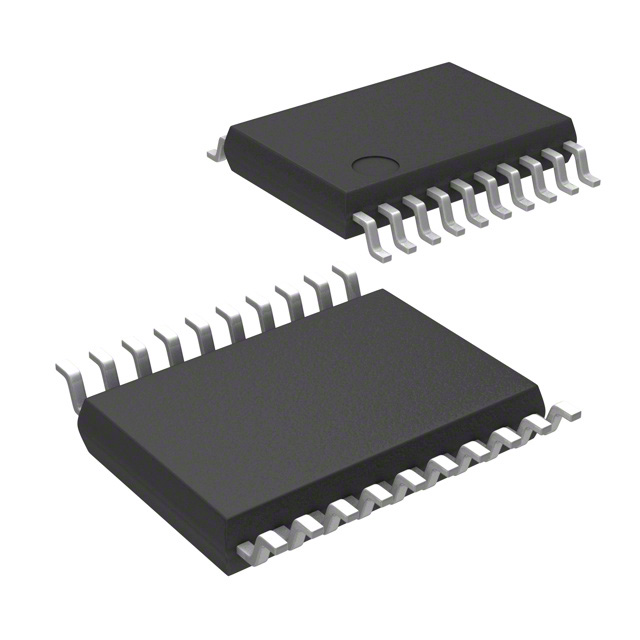 | 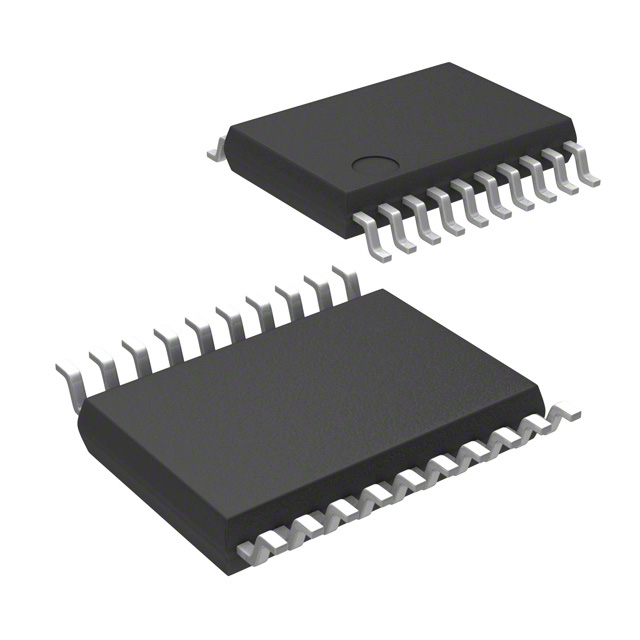 | 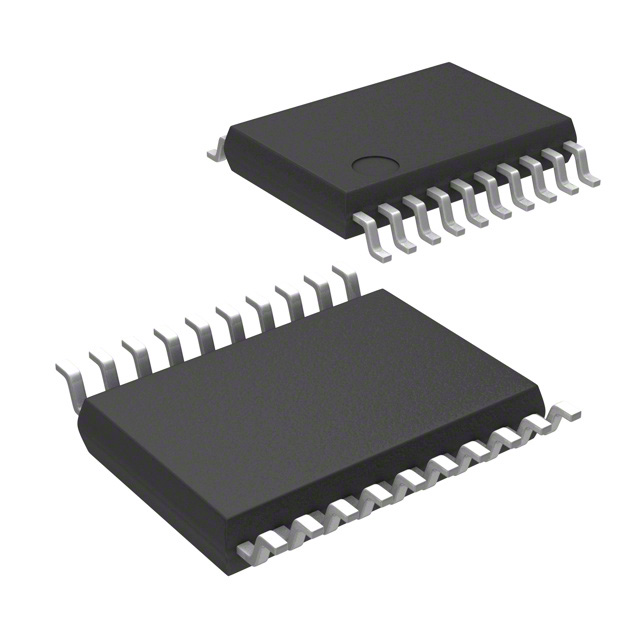 | 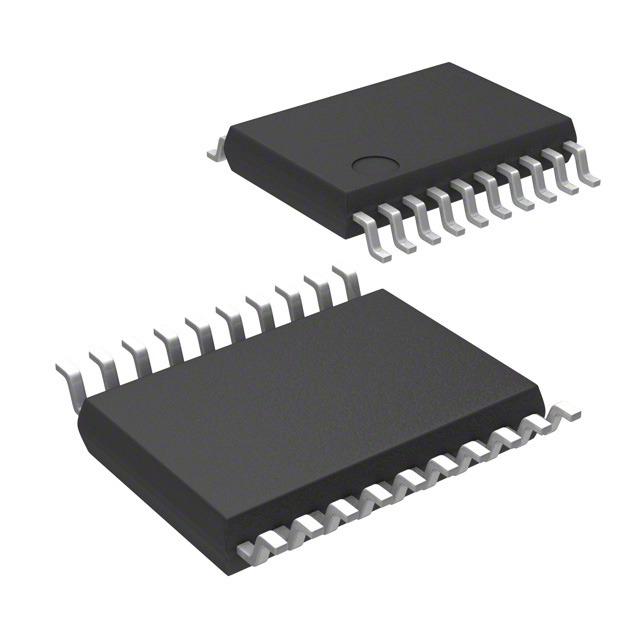 | 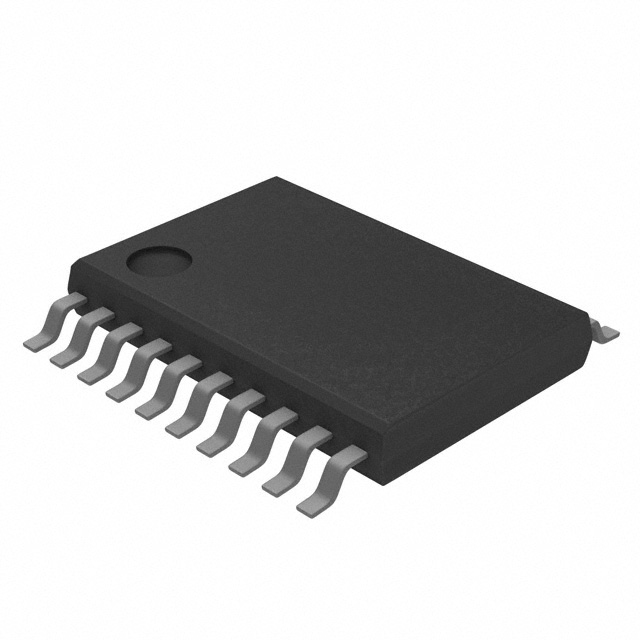 |
| Manufacturer | STMicroelectronics | STMicroelectronics | STMicroelectronics | STMicroelectronics | Microchip Technology |
| Core | STM8 8-bit RISC | STM8 8-bit RISC | STM8 8-bit RISC | STM8 8-bit RISC | AVR 8-bit RISC |
| Max Clock Frequency | 16 MHz | 16 MHz | 16 MHz | 16 MHz | 12 MHz |
| Flash Memory | 8KB Flash | 8KB Flash | 8KB Flash | 8KB Flash | 4KB Flash |
| SRAM | 1KB SRAM | 1KB SRAM | 1KB SRAM | 1KB SRAM | 256B SRAM |
| EEPROM | 128 bytes | 128 bytes | 128 bytes | 128 bytes | 256 bytes |
| Operating Voltage Range | 2.95V to 5.5V | 2.95V to 5.5V | 2.95V to 5.5V | 2.95V to 5.5V | 1.8V to 5.5V |
| Operating Temperature Range | -40°C to +85°C | -40°C to +85°C | -40°C to +85°C | -40°C to +85°C | -40°C to +85°C |
| I/O Pins | 20 Pins | 20 Pins | 20 Pins | 20 Pins | 20 Pins |
| Timers | 2 Timers | 2 Timers | 2 Timers | 2 Timers | 3 Timers |
| ADC | 10-bit ADC (8 Channels) | 10-bit ADC (8 Channels) | 10-bit ADC (8 Channels) | 10-bit ADC (8 Channels) | 10-bit ADC (4 Channels) |
| Communication Interfaces | I2C, SPI, UART | I2C, SPI, UART | I2C, SPI, UART | I2C, SPI, UART | SPI, USART |
| Watchdog Timer | Yes | Yes | Yes | Yes | Yes |
| Internal Oscillator | Yes (Internal RC Oscillator) | Yes (Internal RC Oscillator) | Yes (Internal RC Oscillator) | Yes (Internal RC Oscillator) | Yes (Internal RC Oscillator) |
| Package | LQFP-32 / TSSOP-20 / UFQFPN-20 | LQFP-32 / TSSOP-20 / UFQFPN-20 | LQFP-32 / TSSOP-20 / UFQFPN-20 | LQFP-32 / TSSOP-20 / UFQFPN-20 | TSSOP-20 / QFN-20 |
| Power Consumption | Low Power Modes | Low Power Modes | Low Power Modes | Low Power Modes | Low Power Modes |
| External Interrupts | Yes | Yes | Yes | Yes | Yes |
| External Clock Input | Yes | Yes | Yes | Yes | Yes |
If you require more flash memory, SRAM, and ADC channels, the STM8S003F3P6TR, STM8S103F3P6, or STM8S103F2P6TR would be a better choice.
If you need a smaller flash memory and SRAM with fewer ADC channels and fewer communication interfaces, the ATTINY461-15XD is a suitable option for simpler tasks with lower power requirements.
STM8S003F3P6TR PDF Datasheet
STM8S003F3P6TR Typical Applications
Small Embedded Systems: Suitable for home appliances, smart devices, sensor applications, etc. due to its low cost and reasonable performance.
Battery-Powered Devices: Suitable for battery-driven devices that require low power consumption, such as remote controls, handheld devices, etc.
Industrial Automation: Supports a variety of peripheral interfaces, suitable for control systems and industrial automation equipment.
Sensors and Monitoring Systems: Its ADC and communication interfaces make it suitable for sensor acquisition and remote monitoring applications.
STM8S003F3P6TR Pin Diagram
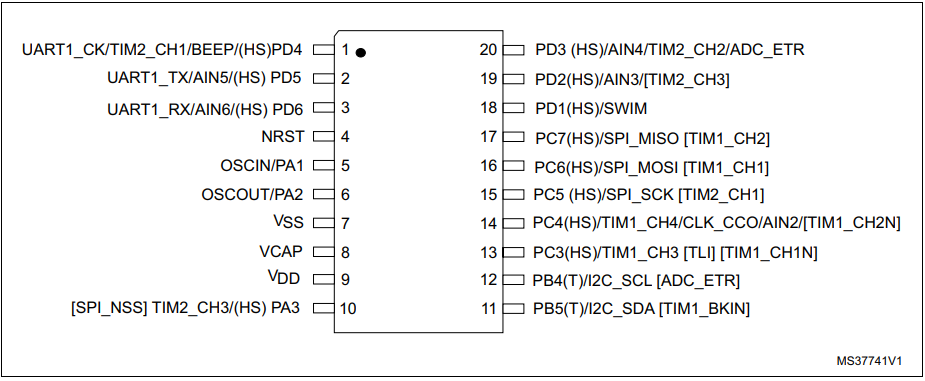
STM8S003F3P6TR FAQs
1. What is the maximum clock frequency of the STM8S003F3P6TR?
16 MHz, the maximum operating clock frequency of this microcontroller is 16 MHz, which can meet the requirements of most small and medium-sized embedded applications.
2. What operating voltage range does the STM8S003F3P6TR support?
2.95V to 5.5V, it can adapt to a wider voltage range and is suitable for different power supply environments.
3. How much Flash storage and SRAM does the STM8S003F3P6TR have?
8KB Flash storage is used for program storage,
1KB SRAM is used for temporary data storage.
4. Does the STM8S003F3P6TR have EEPROM?
Yes, it has a built-in 128-byte EEPROM, which is suitable for applications that require non-volatility, such as storing configuration information, calibration data, etc.
5. What is the ADC resolution of the STM8S003F3P6TR?
The STM8S003F3P6TR is equipped with a 10-bit ADC, which can support up to 8 input channels, suitable for reading signals from analog sensors.
6. What communication interfaces does the STM8S003F3P6TR support?
It supports I2C, SPI, and UART communication interfaces, which can be used for data exchange and control with external devices.
7. What are the number and functions of the timers of the STM8S003F3P6TR?
The STM8S003F3P6TR is equipped with 2 timers, which are 8-bit and 16-bit timers, supporting functions such as PWM output, timing control, and event counting.
8. Does the STM8S003F3P6TR have a watchdog timer?
Yes, the STM8S003F3P6TR has a built-in independent watchdog timer, which can ensure that the system automatically resets when a fault occurs, improving system reliability.
9. What is the operating temperature range of the STM8S003F3P6TR?
-40°C to +85°C, suitable for industrial environments and various embedded applications, and can work normally under relatively extreme temperature conditions.
10. Does the STM8S003F3P6TR support external clock input?
Yes, the STM8S003F3P6TR supports external clock input, and an external crystal oscillator can be used to provide a clock source, which is suitable for applications that require higher clock accuracy.
11. What is the package type of the STM8S003F3P6TR?
The STM8S003F3P6TR uses an LQFP-32 package with a package size of 6.5mm x 6.4mm, which is suitable for space-constrained applications.
12. Does the STM8S003F3P6TR have a low power mode?
Yes, the STM8S003F3P6TR has multiple low power modes, which are suitable for battery-powered devices and can extend battery life.
13. What is the programming language of the STM8S003F3P6TR?
The STM8S003F3P6TR is mainly programmed in C language or assembly language, and STMicroelectronics provides relevant development tools and library support.
14. Does the STM8S003F3P6TR support hardware division?
Yes, the STM8S003F3P6TR supports hardware division instructions, which can speed up division operations and improve processing efficiency.
15. What are the main application areas of the STM8S003F3P6TR?
Home appliance control: such as smart home, washing machine, etc.
Industrial automation: such as sensor interface, automation control, etc.
Sensor node: suitable for small sensor applications.
Battery-powered devices: such as portable devices and low-power applications.
16. How to program and debug the STM8S003F3P6TR?
The STM8S003F3P6TR can be programmed and debugged via ST-Link or JTAG/SWD debugger. Use STM8 Development Tools (such as IAR Embedded Workbench or STMicroelectronics' STM8CubeMX) for development and debugging.
STMicroelectronics
En stock : 17215






